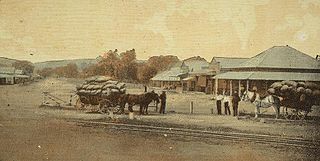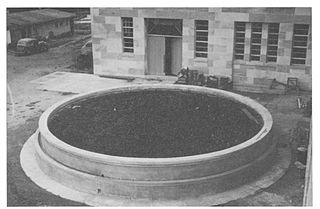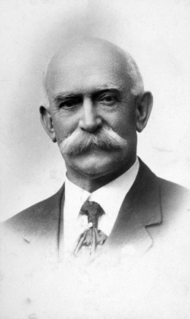Related Research Articles

The Courier-Mail is an Australian newspaper published in Brisbane. Owned by News Corp Australia, it is published daily from Monday to Saturday in tabloid format. Its editorial offices are located at Bowen Hills, in Brisbane's inner northern suburbs, and it is printed at Murarrie, in Brisbane's eastern suburbs. It is available for purchase throughout Queensland, most regions of Northern New South Wales and parts of the Northern Territory.

The Supreme Court of Queensland is the highest court in the Australian State of Queensland. It was formerly the Brisbane Supreme Court, in the colony of Queensland.

Holy Name Cathedral was a planned but never-built Roman Catholic cathedral for the city of Brisbane, Queensland, Australia. Designed by Hennessy, Hennessy & Co, initially in an English Baroque style inspired by St Paul's in London, it was intended to have been the largest church building of any Christian denomination in the Southern Hemisphere. James Duhig, the Archbishop of Brisbane, was the chief proponent of the project. First designed in 1925, building began in 1927 and in the 1930s services were held in the crypt chapel on the site, the only part to be built. No further construction took place, and with Duhig's death in 1965 the project lost its impetus, but was not formally abandoned until the 1970s. The archdiocese sold the site to property developers in 1985, the crypt was demolished and an apartment complex was built on the site. Today the perimeter wall along Ann Street and part of Gotha Street are all that remain, and were heritage-listed in 1992.

Helidon is a rural town and locality in the Lockyer Valley Region, Queensland, Australia. In the 2016 census, the locality of Helidon had a population of 1,059 people.

The Toowoomba Chronicle is a daily newspaper serving Toowoomba, the Lockyer Valley and Darling Downs regional areas in Queensland, Australia.

Meta Truscott was an Australian diarist and Ashgrove historian. For over 80 years, she wrote a daily diary and collected scrapbooks, with pasted-in newspaper clippings and other ephemera (1934–2014). The diaries record the day-to-day life of a woman who had lived in Queensland all her life. The collection is in the Fryer Library, University of Queensland.

Jeremiah Joseph Stable (1883–1953) was the first professor of English at the University of Queensland in Brisbane, Queensland, Australia.
Hennessy & Hennessy was an architectural firm established in 1912 in Sydney, Australia that was responsible for a series of large scale office buildings in the 1930s in all capital cities in Australia, as well as New Zealand and South Africa, designed by John (Jack) Hennessy (1887–1955), described as Australia's first international architect.

The University of QueenslandSeismology Station was established in 1938 at the University of Queensland, Brisbane, Australia.

Kathleen Campbell-Brown (1903–1996) was a lecturer in French at the University of Queensland for almost 30 years.

Her Majesty's Theatre, Brisbane (1888–1983), opened as Her Imperial Majesty's Opera House in Brisbane, Australia on 2 April 1888. It was the largest theatre in Brisbane. It was located at 193 Queen Street, Brisbane. Its façade was in the Italian Renaissance and Corinthian style.
Vitaly de Gzell (1908-1977) was a Russian-Australian architect, who practised in Queensland in the modernist tradition.
Frank Cullen (1909-1991) was an Australian architect, who designed over 200 churches, school, monasteries, convents and other church related buildings in Queensland and Northern New South Wales, Australia
Dance Halls of Brisbane in the twentieth century were popular venues for entertainment, socialising and reflected styles of music, architecture, popular culture and city planning.

Henry Mobsby (1860–1933) was a British/Australian artist and photographer, who helped film some of the earliest motion pictures produced in Australia.
Cribb & Foote was a department store in Ipswich, Queensland, Australia, that existed from 1849 until 1985. It was renamed Reid's department store in 1977.

Walter Cunningham Hume (1839–1921) was a British surveyor who emigrated to Australia to provide for his family. He spent almost 40 years surveying the Darling Downs region of Queensland, helping to develop land policy. He was an active photographer whose work reflected life in Australia pre-Federation.
Charles Da Costa (1889-1974) was an Australian architect known for his work as a railway architect in Queensland. He specialised in reinforced concrete and structural steel designs.
Lindsey Page Winterbotham (1887-1960) was an Australian doctor and anthropologist, who helped to establish the Anthropology Museum at the University of Queensland.
References
- 1 2 East, John W. (2017). "Acclimatising a Foreign Transplant: The "Old English" House in Brisbane between the Wars". espace.library.uq.edu.au. Retrieved 4 November 2019.
- 1 2 Watson, Donald; McKay, Judith (1984). "A Directory of Queensland Architects to 1940". espace.library.uq.edu.au. Retrieved 4 November 2019.
- ↑ "Arthur Bligh". qldarch.net. Retrieved 4 November 2019.
- 1 2 3 4 5 6 7 Bennett, Helen Margaret (2011). Interpreting the Modern: Flatland in Brisbane 1920-1941 Living in Multiple-Occupancy Dwellings in Interwar Brisbane (Griffith thesis thesis). Griffith University.
- 1 2 "Master of strategic thinking". Courier Mail. 20 August 1998.
- ↑ Shaw, Barry (2019). Brisbane commerce : construction and controversies 1840-2018. Brisbane History Group. ISBN 9781925877144.
- ↑ "Brisbane: $40m Bligh plan". The Bulletin. Vol. 89, no. 4558. 15 July 1967. p. 23 – via Trove.
- ↑ "The Bligh Plan". Canberra Times (ACT : 1926 - 1995). 15 April 1967. p. 2. Retrieved 4 November 2019– via Trove.
- ↑ "BLIGH—GAYDON". Brisbane Courier (Qld. : 1864 - 1933). 1 January 1931. p. 14. Retrieved 4 November 2019.
- ↑ Franklin, Matthew (2 March 1989). "Bligh dynasty about to produce third achitect". Courier Mail.
- 1 2 "BRISBANE ART DECO: STORIES OF OUR BUILT HERITAGE" (PDF). 2015.
- ↑ "Carmel Court | Heritage Places". heritage.brisbane.qld.gov.au. Retrieved 21 December 2019.
- ↑ Campbell, Janet (2009). "Camden: Hillside apartments". Brisbane Modern. 3: 13. hdl:10462/pdf/8557.